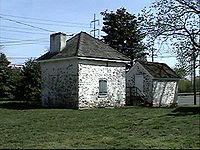
Block House
Encyclopedia

Claymont, Delaware
Claymont is a census-designated place in New Castle County, Delaware, United States. The population was 9,220 at the 2000 census.-History:...
. The Block House is believed to be the only structure remaining of original settlement on Naaman's Creek
Naaman's Creek
Naamans Creek is a tributary of the Delaware River in northeast New Castle County, Delaware and southeast Delaware County, Pennsylvania The stream rises near the intersection of Foulk Road and Naamans Creek Road at in Bethel Township, Pennsylvania, flows through Arden, Delaware, and discharges...
.
History

New Sweden
New Sweden was a Swedish colony along the Delaware River on the Mid-Atlantic coast of North America from 1638 to 1655. Fort Christina, now in Wilmington, Delaware, was the first settlement. New Sweden included parts of the present-day American states of Delaware, New Jersey, and Pennsylvania....
. Chief Peminacka of the Minqua tribe
Susquehannock
The Susquehannock people were Iroquoian-speaking Native Americans who lived in areas adjacent to the Susquehanna River and its tributaries from the southern part of what is now New York, through Pennsylvania, to the mouth of the Susquehanna in Maryland at the north end of the Chesapeake Bay...
had deeded the large tract of land along Naaman’s Creek to John Risingh on behalf of the Swedish colony. The structure was originally designed for defense. During September 1655, the Block House was taken by the Dutch West India Company
Dutch West India Company
Dutch West India Company was a chartered company of Dutch merchants. Among its founding fathers was Willem Usselincx...
under Peter Stuyvesant
Peter Stuyvesant
Peter Stuyvesant , served as the last Dutch Director-General of the colony of New Netherland from 1647 until it was ceded provisionally to the English in 1664, after which it was renamed New York...
at the same time Dutch forces captured Fort Christina
Fort Christina
Fort Christina was the first Swedish settlement in North America and the principal settlement of the New Sweden colony...
. In 1671, the Block House was attacked by Indians
Indigenous peoples of the Americas
The indigenous peoples of the Americas are the pre-Columbian inhabitants of North and South America, their descendants and other ethnic groups who are identified with those peoples. Indigenous peoples are known in Canada as Aboriginal peoples, and in the United States as Native Americans...
. It was captured by the British
Great Britain
Great Britain or Britain is an island situated to the northwest of Continental Europe. It is the ninth largest island in the world, and the largest European island, as well as the largest of the British Isles...
in 1777 during the Revolutionary War.
Several yards south of the Block House is the Robinson House. The Block House consists of one room with a lower and upper level. Inside is a relatively large fireplace and the former living quarters for the Robinson House cook.
The correct date of construction has recently been disputed. Some say the Block House was not built until later, possibly around the time the Robinson House was built in 1723.
Other sources
- Johnson, AmandusAmandus JohnsonAmandus Johnson was an American historian, author and founding curator of the American Swedish Historical Museum...
Johan Classon Rising: The Last Governor of New Sweden (Philadelphia: The Swedish Colonial Society, 1915) - Ward, Christopher. Dutch and Swedes on the Delaware, 1609 - 1664 (University of Pennsylvania Press, 1930)

